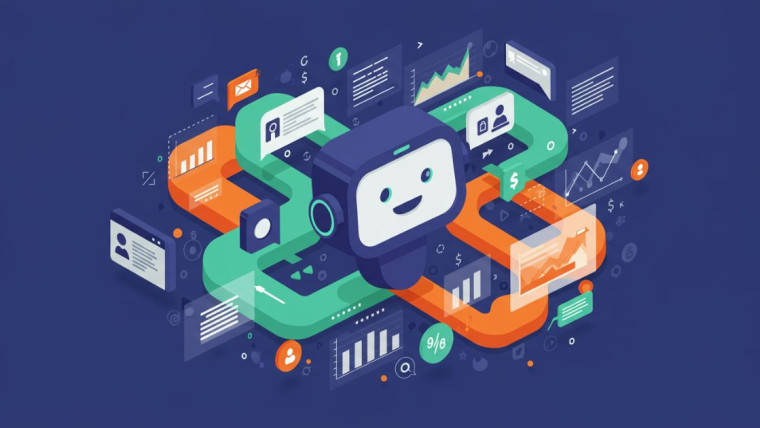Web chatbots are everywhere. These AI-driven assistants, from customer service representatives to online sales clerks, assist millions of individuals each day. But as chatbot security and privacy concerns also come to the fore.
Many users don’t realize just how much personal information they are providing to chatbots. Others fear that their conversations could be the subject of a data breach or that they could be used against them. Know these three risks if you’re a business owner who uses chatbots a lot.
This guide addresses the top privacy and security issues with web chatbots. You’ll discover the most frequent threats and protection strategies, as well as how to select secure chatbot solutions. By the end, you will know exactly what to look for so that your data remains secure.
What Are Web Chatbot Privacy Risks?
Privacy concerns associated with web chatbots are when personal data is captured, saved, or used without the person’s consent. Both corporations and individual users are vulnerable to these risks.
Data Collection Without Clear Consent
Many chatbots record data from all conversations. This also covers messages, your IP address, device information, and browsing patterns. Most users are not aware that this data collection is going on.
The issue is compounded when chatbots do not properly disclose what data they are gathering. Users can post things they think are private. Without appropriate consent models, this might entail severe privacy infringements.
Conversation Storage and Retention
Your chatbot chats are frequently stored on company servers. Some businesses hold that information for months, years, even. This creates a long-term privacy risk if the data is accessed each time by unauthorized persons.
Your conversation data could also be used by companies to train their AI systems. Though it’s good for your chatbot’s performance, since you contact that server, it means your personal information contributes to building future prods.
Third-Party Data Sharing
Your data is shared with third-party companies by many chatbots. This could be analytics providers, cloud storage services, or advertising partners. The more companies that touch your data, the more places it can expose you to privacy risks.
A few chatbots link in with those social media platforms or other services. These connections may be able to tie your chatbot chats to other things you do online, leading to detailed profiles of your behavior.
Common Chatbot Security Risks

Chatbot risks are leaks in the security of your data, privacy, or digital safety. These threats vary from weaknesses in the system to social engineering hacks.
Data Breaches and Server Vulnerabilities
There is a vast amount of information about users in chatbot systems. When hackers penetrate these systems, they can harvest thousands of private conversations. Multiple recent hacking incidents have compromised delicate consumer data from major companies.
Vulnerable servers raise the likelihood of this kind of breach. Vulnerable Software Outdated software, weak passwords, and insecure configurations serve as cybercriminals’ welcome points. Once a victim logs in, hackers can steal personal information or install malicious programs.
Malicious Chatbot Attacks
Con artists can even generate artificial chatbots to extract information. These bad Bots could be on a good website or social media. They trick people into giving up passwords, credit card numbers, or other personal information.
Some attacks have deployed chatbots that spread malware or phishing links. Fishing provides apparent important responses and links to viruses or dangerous websites.
Social Engineering Through Chatbots
This is how professional attackers operate using chatbots: Social engineering attacks. They script bots to ask seemingly benign questions that can expose personal information. Over time, they said, these small details allow criminals to steal your identity or perpetrate a fraud.
Social engineering attacks succeed because chatbots appear to be conversational and helpful. Users instinctively seek to share details to receive the best possible help. This trust is then being abused by criminals to collect valuable data.
Inadequate Authentication Systems
Most chatbots don’t perform thorough identity checks. Feeble authentication systems allow outsiders to see private conversations or sensitive business information. This poses dangers for both individual users and corporations.
Some chatbots keep authentication tokens or session data insecurely. If stolen, these tokens can be used by attackers to masquerade as legitimate users to gain access to protected information.
How to Derive a Secure Chatbot Solution

Safe chatbot providers keep you safe and your data secure with a series of safety nets. Knowing what to look for can help you make safer choices.
End-to-End Encryption
Seek out chatbots that encrypt end-to-end. This system encrypts your messages so that only you and the person you are messaging with can read them. The encryption itself is not something to worry about; even if your network data is intercepted by someone, they cannot comprehend the information if it is encrypted.
Modern protocols like TLS 1.3 or AES-256 employ strong encryption. These protocols are highly effective at addressing the majority of cyber threats. Avoid chatbots that do not clearly mention their encryption techniques.
Clear Privacy Policies
Secure chatbots have detailed, easy-to-understand privacy policies. These documents explain what data gets collected, how it’s used, and who has access to it. Good privacy policies also describe your rights and how to delete your data.
Red flags include vague language, missing contact information, or policies that haven’t been updated recently. Legitimate companies regularly review and update their privacy practices.
Data Minimization Practices
The best chatbots seek only the information they actually need. The principle, known as data minimization, decreases the risk to privacy because there is less data available to be stolen or misused.
Secure apps also provide the possibility to erase your conversation history. For some chatbots, you can apply anonymous modes or temporary glass rooms that won’t save your data permanently.
Regular Security Audits
Reliable chatbot companies perform code reviews with security in mind. They uncover vulnerabilities and verify whether defensive mechanisms are functioning properly. Watch for businesses that release security reports or have attained third-party certifications.
Some providers have even created bug bounty programs. These programs compensate security researchers for discovering and reporting bugs. This strategy is for spotting issues that cyber criminals can exploit.
Optimal Practice for Protecting the Privacy of Chatbots
Keeping your privacy when interacting with chatbots is not as simple. These habits reduce the chances of risk and safety of your personal information.
Limit Personal Information Sharing
Only include the information that is relevant to your request. Never give your last name, address, or financial information to a chatbot unless strictly necessary. There are lots of chatbots that can help you without accessing private, sensitive personal data.
Especially watch out for government ID numbers or passwords or medical information. Such specifics also pose a big risk if taken by the wrong people.
Use Anonymous or Temporary Modes
Some chatbots have an anonymizing or transient session mode. These are designed to keep your chats from being stored or tied to your identity. Wherever possible, use these options, but remember that not all of the sensitive subjects can be shared using them.
Some browser vendors provide private or incognito browsing modes as well. While these are not going to keep you completely secure, not storing any data locally trumps these.
Regularly Review and Delete Data
Your chatbot conversation history should be monitored. Remove old conversations with personal information you no longer want to discuss. Most platforms allow you to download your data before deleting it.
If you don’t see any deletion options, reach out to the company directly. Many countries have privacy laws that mandate companies to delete personal data upon request.
Stay Updated on Privacy Policies
Companies do occasionally revise their privacy policies. Find out more about how your data is used and whether there have been any policy updates based on browsing and other activity. Most firms notify when they make substantial changes.
If you don’t like the new privacy terms, you can stop using the service and get your data deleted.
Chatbot Security – How To Be Smart About It
Knowing your chatbot UX and security privacy makes you an informed user, and one who can determine which services are effective or worth using. The dangers are real, but the proper precautions can go a long way toward minimizing them.
Begin by assessing the chatbots you have running now. Review their privacy policies, security protocols, and data handling. Find more secure alternatives to services that don’t meet your privacy standards.
For enterprises, placing trust in secure chatbot solutions will, of course, ensure you’re protecting your company and its users. Securing an application correctly is not expensive compared to the risk of being breached or the potential damage of a privacy violation.
Keep in mind that chatbot security is a journey, not a destination. Continuously be aware of fresh threats and defence technologies. Maintaining a regular focus on these matters will help assure your personal information stays safe in a world that is ever more connected.








Chatbots for Customer Retention: How AI Improves Loyalty and Reduces Churn
Transforming Employee Onboarding with AI Chatbots: A Step-by-Step Guide
Emergency Response Chatbots: Revolutionizing Crisis Management with AI
Revolutionizing Recruitment: How Chatbots Streamline Hiring Processes and Elevate Talent Acquisition